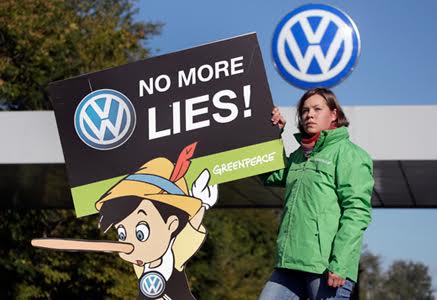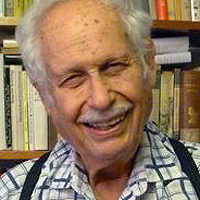
BERLIN — That “blood moon” was quite a sight. Not being superstitious, I see in it no omen. Indeed, for a layman like me, it was amazingly predictable, one of the few predictable things in today’s world.
Who could have predicted the Volkswagen disaster?
In April VW boss Martin Winterkorn, whose company already had the highest revenues, profits and assets of any automaker, boasted proudly that by 2018 VW would be “the world’s most profitable, fascinating and sustainable auto manufacturer, with annual sales of 10 million vehicles and a pretax profit margin of 8 percent or higher” and “the most satisfied customers and employees (550,000 worldwide) in the industry. Only an automaker who can achieve all these goals can really call itself number one with justification.”
If there is any justice left lying around, by 2018 Winterkorn should be in a less joyous, more restricted situation, and not alone. His assertions that he (and other top managers) never knew of the vicious deception [caught cheating on diesel emissions, could face billions in fines] which has poisoned enough atmosphere to cost too many lives, calls up many a knew-nothing recollection.
Secrets involving diesel motors, popular in Europe with gas far more expensive than in the U.S., go back exactly 102 years. On the night of September 29 1913 inventor Rudolf Diesel disappeared from a ship crossing to England, after probably jumping overboard for no known reason.
Similar reactions are not expected of anyone today despite the billions VW will most likely have to cough up. It has wonderful connections. Once publicly owned, a key twenty percent is still property of the state of Lower Saxony, and all politicians from that state enjoyed close ties, like former chancellor Gerhard Schröder and current vice-chancellor Sigmar Gabriel. Other heavy weight firms may well get caught up in this giant, world-wide plot against the environment and political ties with the whole auto industry have always been hearty, with Daimler-Benz and BMW joining in to impel Merkel to achieve a delay in European Union emission limits until 2022.
A symbol was offered by Matthias Wissmann, long the Minister of Transportation, who quit his Bundestag seat on May 30 2007 and showed up on June 1, no doubt with a good new suit and tie, as President of the Automobile Industry Association and soon vice-president of its Pro Mobilität lobby, whose main jobs are to cut railroad traffic and instead build ever wider highways, while preventing changes in Germany’s “No speed limit” rules on many Autobahn stretches, which would discourage high-power vehicle sales. This too causes many hundreds of deaths.
But nothing is fully predictable. Since autos are a key factor in Germany’s economic grip on Europe and elsewhere, a big drop in sales, especially of VWs, might just upset many an apple cart. In former GDR (East Germany) areas, plagued by joblessness since the western take-over just 25 years ago, there have been signs of a recovery in a few centers called “lighthouses,” with 6600 VW workers in Zwickau (home of the GDR’s Trabant cars), 515 in Dresden, 3250 making related Porsches in Leipzig and 4700 BMW workers in Leipzig. How many will still have jobs next year, after 26 years of German reunification?
I also feel sorry for VW workers in Tennessee, whose billion dollar Passat plant, after big quarrels and giant subsidies, might now collapse. Perhaps Chattanooga should have stuck to its choo-choo!
There’s no predicting which big scandal company will be next.
Pharma again? More billionaire tax evaders? The plant poisoners and bee killers? Oil drillers? The giant new Berlin airport, named for Willy Brandt and scheduled to open in 2012, has been plagued by one delay after another, causing the political death of once-popular mayor Klaus Wowereit but filling the deep pockets of many an incompetent and/or crooked construction firm and “expert.” Now the butt of a thousand increasingly sour gags, it may just make it and open in 2017. Home owners in the region hope not!
Happily, there’s also movement in opposing directions, by which I do not mean the milling crowds and annual fireworks and colored lights marking the 25 years of German unity, with all the beer, bockwurst, bands and big shots tearfully singing “Deutschland über alles.”
Movement in opposing directions
No, I mean the September 19 counter-demonstration to the annual anti-abortion march of the fundamentalists, who want to revoke modest gains in women’s rights won for West Germans after the downfall of the GDR (which had full freedom of choice, with abortions and all birth control expenses fully covered by medical insurance). Our two parades almost matched theirs in size, although they bussed in gimlet-eyed “baby-defenders” from all over Germany and maybe Poland. We had a jolly crowd, with hard-hitting but often funny, daring posters and banners, and our parades were cheered along by nearly all passers-by.
I also mean the protest march near Ramstein on September 26. This, HQ of the United States Air Forces in Europe, U.S. Air Forces in Africa and HQ of NATO’s Allied Air Command, is the biggest U.S. military air base outside home territory, with 35,000 in uniform that guide the drones on their death missions!
The demonstrators, organized by the Left party and many peace organizations, carried posters and banners which were less jolly than the ones in Berlin but equally determined: “No to the Killer Drones!” “This Is Where Murder Is Organized,” “Allies Go Away,” “Out of NATO” or simply “For Tolerance and Peace.” Most of the media was sarcastic about the small number, but getting almost 2000 people, mostly young, to this out-of-the-way site about 25 miles from the French border was an encouraging success and may help bridge fissures long troubling the peace movement.
One added motivation: a few weeks earlier the U.S. Army Europe, with 1500 parachute jumpers, ran an exercise called Swift Response, training for “a multinational airborne joint forcible entry operation across four European nations… the largest allied airborne training event on the continent since the end of the Cold War.” Its aim: “…to integrate multiple allied nations’ high-readiness forces to operate as a cohesive team and demonstrate the alliance’s capacity to rapidly deploy and operate in support of maintaining a strong and secure Europe.” Soldiers from NATO nations – Poland, Bulgaria, France, Germany, Greece, Italy, the Netherlands, Poland, Portugal, Spain, the UK and the U.S. also trained far too close to Russia in Bulgaria and Romania. This might explain one big peace demonstration banner demanding “Peace with Russia – Not Closer to World War III”.
Another big demonstration in Berlin, now in the offing for October 10th, may have lots of balloons but no parachute jumpers. It will protest planned trade agreements between the European Union and Canada (CETA) and between the EU and the U.S., the Transatlantic Trade and Investment Partnership (TTIP). Both, like TPP, grant immense power to giant companies, with inconspicuous arbitrators cutting at labor gains and ecological rulings against poisonous insecticides or dubious genetic changes and whatever else obstructs huge profits. Many unions, environmental groups, the Left and many Greens want a giant turnout to warn the government against signing any such treaties.
It is hard to make predictions about Angela Merkel.
Will she and Vice-Chancellor Sigmar Gabriel, a Social Democrat, fight on for the trade treaties, resisting growing pressure from the people? And will they dance along with the threatening music blared at Putin, or further tread the thin line between floor thumpers in their own ranks, with bellicose pressure from Washington, and their haunting, often haunted hunt for some form of compromise in the Ukraine and Syria, placating business interests hoping to forestall a backward lurch in German economic dominance (with VW the latest and biggest worry.
And, after zigzagging on the question of the huge wave of immigrants from the Near East, Africa and southeastern Europe, will she bow to mounting pressure, first to restrict European refugees, mainly Roma people (Gypsies), viciously discriminated against in or around former Yugoslavia, which was split into today’s weak fragments under pressure – and some heavy air strikes – from Germany? Merkel is feeling the hot breath of far right hate-mongers, in and outside her own party; will she bow to them or keep on that fine line? As in the U.S., they can get out of hand and become dangerous!
After twenty-five years of unification, annexation or occupation, or whatever people call it, the only safe predictions in Germany still seem to be the ones about lunar eclipses.
Photo: An activist of the environmental protection organization ‘Greenpeace’ holds a protest poster in front of a factory gate of the German car manufacturer Volkswagen in Wolfsburg, Germany, Sept. 25. The supervisory board met there to discuss who to name as CEO after Martin Winterkorn quit the job this week over an emissions-rigging scandal that’s rocking the world’s top-selling automaker. (AP Photo/Michael Sohn)










